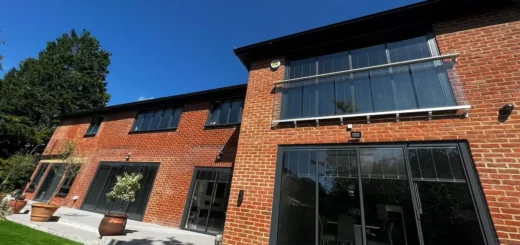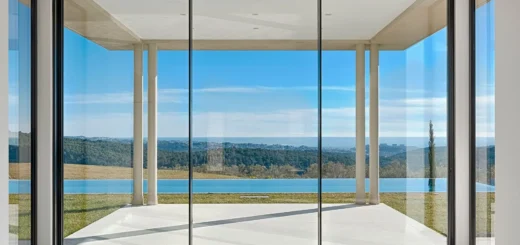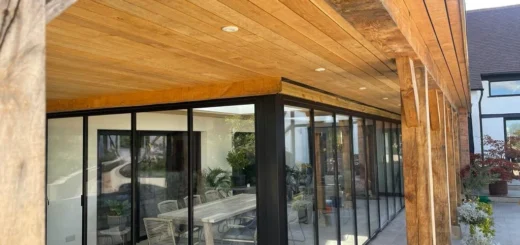Guide to Conservatory Sliding Doors: Internal & External
Table of Contents
Thinking about getting some conservatory sliding doors? This guide covers everything you need to know about internal and external options, helping you pick the right doors for your conservatory.
What Makes Sliding Doors Right for Your Conservatory?
Modern conservatory sliding doors offer practical solutions for both internal and external spaces. Unlike hinged doors that swing open, sliding mechanisms move parallel to your walls, saving valuable floor space in your conservatory. The large glass panels let natural light flow through your home while providing smooth access to your garden or main living area. Whether you’re planning to replace old doors or design a new conservatory, sliding conservatory doors offer flexibility in how you use your space.
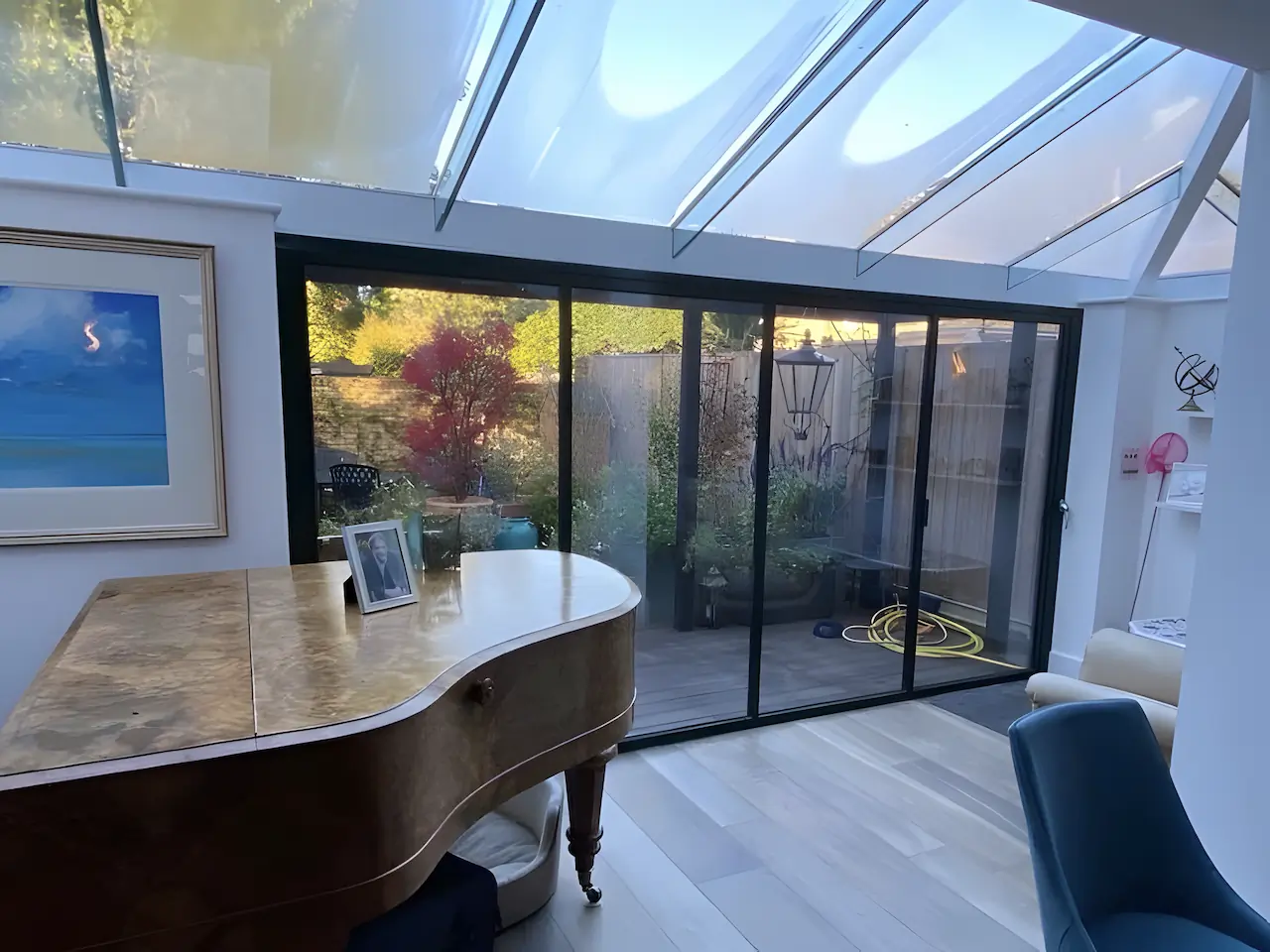
How Sliding Conservatory Doors Work
Sliding door systems run on tracks fitted at the top and bottom of your conservatory’s frame. Most conservatory sliding doors use rollers housed in the door frame’s bottom rail, which glide along a floor-mounted track. The top track guides the door and prevents it from tipping forward or back. This dual-track system ensures the doors move smoothly and stay aligned, even after years of use.
Different track configurations suit various opening widths. Single-track systems work well for smaller sliding conservatory doors where only one panel needs to move.
Double and triple-track options allow multiple panels to slide independently, creating wider openings that blur the boundary between inside and out. The track depth varies between systems – some sit flush with your flooring while others need a small step-over rail.
Key Benefits for Conservatories
Conservatory sliding doors help control temperature throughout the year. In summer, you can slide them fully open for fresh air, while their thermal properties keep warmth in during colder months. The glass panels bring in plenty of natural light, which helps your conservatory feel bright and spacious all year round.
Modern glazing technology makes these doors practical in British weather. Double or triple-glazed panels filled with argon gas improve insulation, while special coatings reflect excess heat in summer and retain warmth in winter. This helps maintain comfortable temperatures without relying heavily on heating or cooling systems.
Space-Saving Design Features
The sliding mechanism proves particularly useful in smaller conservatories where every inch counts. Unlike traditional hinged doors that need clearance to swing open, conservatory sliding doors stack neatly against one another. This space-efficient design means you can place furniture closer to the doors without blocking access, making the most of your conservatory’s floor area.
Glass panels can span from floor to ceiling, creating unobstructed views of your garden. The frames come in various thicknesses – slimline options have minimal visible frame, while more robust systems offer extra security. Some designs allow panels to slide around corners, opening up two sides of your conservatory completely.
Weather Protection Systems
Quality conservatory sliding doors include weatherproofing features that protect against British weather. Multi-point locking systems compress the doors firmly against weather seals when closed, while brush strips between sliding panels block draughts. The tracks include drainage channels that direct any water away from the inside of your conservatory, keeping the floor dry even during heavy rain.
Modern sliding aluminium doors use thermal breaks – strips of non-conductive material that separate the inner and outer parts of aluminium frames. This technology stops cold from transferring through the frame, reducing condensation on the inside of your conservatory. The glass units themselves are often filled with argon gas and coated with microscopic layers that reflect heat back into your room while letting sunlight through.
Properly installed conservatory sliding doors create a reliable barrier against wind and rain. The bottom tracks incorporate drainage holes that channel away any water that might get past the outer seals. Some systems use concealed drainage paths within the frame itself, helping maintain clean lines while protecting your conservatory from the elements. Rubber gaskets and brush seals work together to block dust and draughts, keeping your conservatory comfortable in all seasons.
Internal Sliding Conservatory Doors
Internal conservatory sliding doors create a flexible boundary between your main living area and conservatory. Glass panels on smooth-running tracks let you open up the space fully in warm weather or maintain a cosy atmosphere during colder months.
Frameless Glass Doors
Pure glass sliding doors offer the cleanest look between your home and conservatory. These systems use toughened glass panels at least 10mm thick, with minimal metalwork hidden in the top and bottom tracks. The glass edges are polished and carefully shaped to allow the panels to slide past each other smoothly. Without visible frames, these conservatory doors almost disappear when closed, letting natural light pass through unobstructed.
Slim frames increase the feeling of space in both rooms. The nearly invisible tracks can be mounted flush with your flooring, removing any trip hazards. Special rollers and brushes keep the glass panels running quietly, while cleverly designed locks secure the doors without spoiling their minimal appearance.
Pocket Doors
Pocket doors slide completely out of sight into a cavity in your wall, making them perfect for connecting your living space to the conservatory. The track system guides the doors into a pre-built pocket, effectively hiding them when open. This setup works particularly well in modern homes where clean lines matter.
The mechanisms need careful planning during installation – the wall cavity must be exactly the right size for your conservatory doors. Most pocket systems use slim profile frames to save space inside the wall. Some designs allow for soft-close mechanisms that prevent the doors from slamming, much like kitchen drawers.
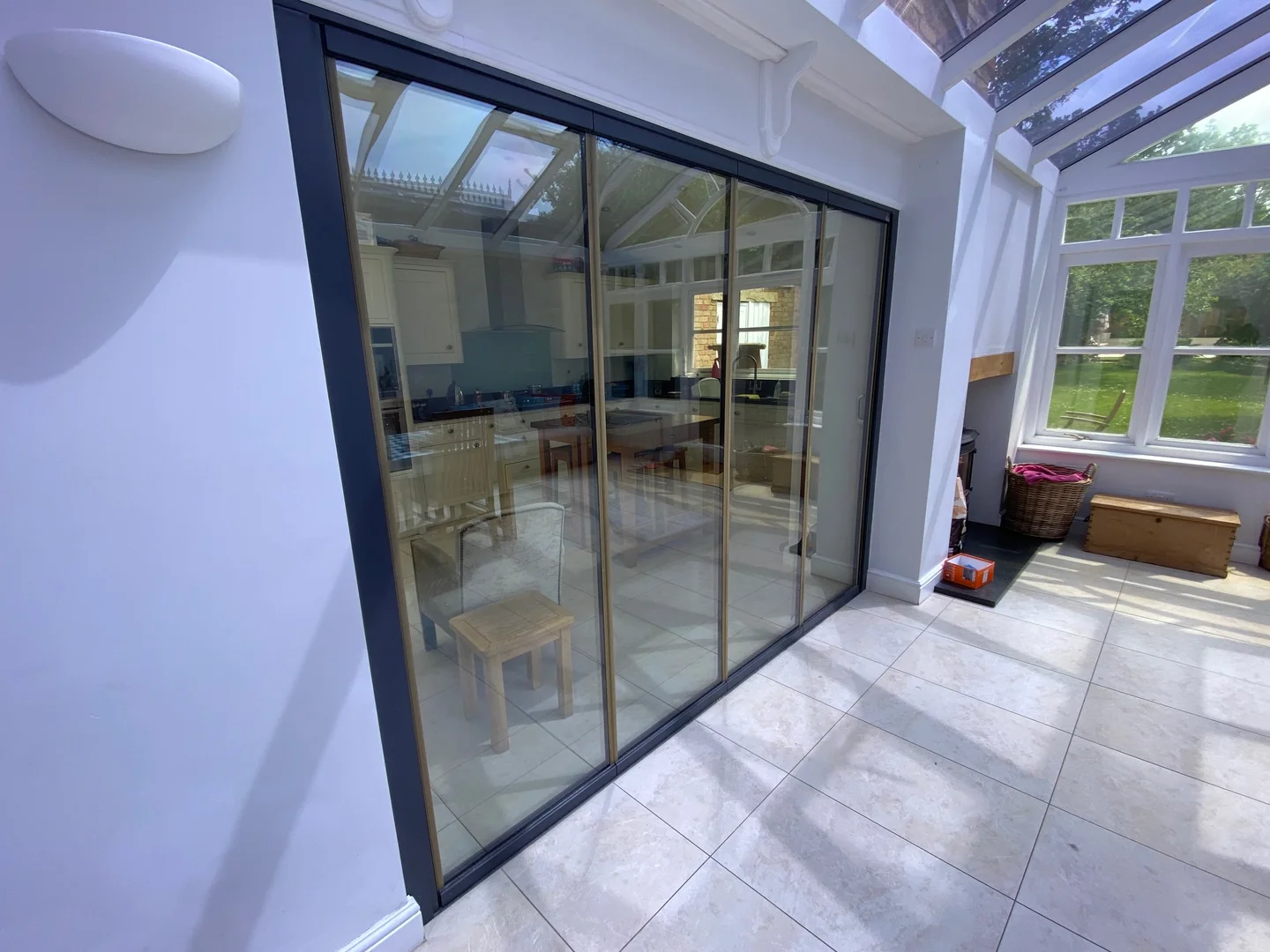
Slide and Turn Systems
These doors combine sliding and pivoting movements, and are a great alternative to traditional interior folding doors or sliding doors. Each panel slides along the track then turns to stack at 90 degrees, tucking neatly against your wall. This gives you more options than standard slide doors – you can open just one panel for quick access or fold them all back for a wide opening.
The minimum frame thickness varies between manufacturers, but most offer slim options that don’t block too much light. Multi-point catches hold each panel securely when closed, while allowing easy release when you want to open them. Special brushes between the panels stop draughts without making the doors hard to move.
Traditional Framed Designs
While modern internal conservatory doors often aim for minimal frames, traditional designs still have their place. These doors typically feature wider frames that match existing timber in your home. The solid frames house the sliding mechanisms and provide space for robust locks and handles.
Different frame materials suit different budgets and styles. Aluminium offers strength with relatively thin sections, while timber brings warmth but needs more substantial profiles. UPVC strikes a balance – its frames can be quite slim while keeping costs down. Many homeowners choose white frames to reflect light, but wood-grain effects and painted finishes let you match your existing interior style.
External Conservatory Sliding Doors
External conservatory sliding doors connect your indoor space directly to the garden. The latest systems combine security and thermal efficiency while providing wide openings that make your conservatory more useful throughout the year.
Double Track Systems
Modern conservatory doors with double tracks offer smooth operation and reliable security. The panels glide independently, giving you options for ventilation without fully opening the doors. Conservatory patio doors mounted on double tracks typically hold two or four panels, with half the panels sliding and half fixed.
Glass patio doors need proper support along their entire length. Track systems sit either on top of your floor or in a channelled threshold that sits flush with the ground. Low-profile options remove barriers between surfaces while keeping water out. The latest external doors include built-in drainage and brush seals that work together to handle British weather.
Slim sightlines remain possible even in secure external sliding conservatory doors. Modern frame materials let manufacturers reduce visible frame width without losing strength. Double-glazed units sit within these frames, combining thermal performance with clean looks. Some systems hide their locks within the frames, keeping the appearance tidy while maintaining security.
Triple Track Designs
Triple track conservatory sliding doors allow for bigger panel configurations. Each panel moves independently along its own track, letting you position the doors exactly where you want them. When fully open, these systems can clear two-thirds of the entrance – much more than standard sliding doors.
The frames house complex mechanics that make large panels easy to move. Special rollers spread the weight evenly across the tracks, while built-in levelling systems help installers adjust each panel perfectly. Anti-lift devices stop the panels being removed from outside, adding an extra layer of security.
Panel weights vary based on glass type and size, but most systems can handle substantial doors without compromising smooth movement. Some manufacturers offer motorised operation for very large installations. Built-in sensors detect obstacles and stop the doors automatically, making them safe for all users.
Corner Doors
Corner-spanning exterior doors remove the fixed post traditionally needed at the join. When open, these conservatory doors create a completely clear corner that connects your conservatory directly to your outdoor space. The mechanics involved are more complex than standard sliding systems, but the results can make your conservatory feel twice as big.
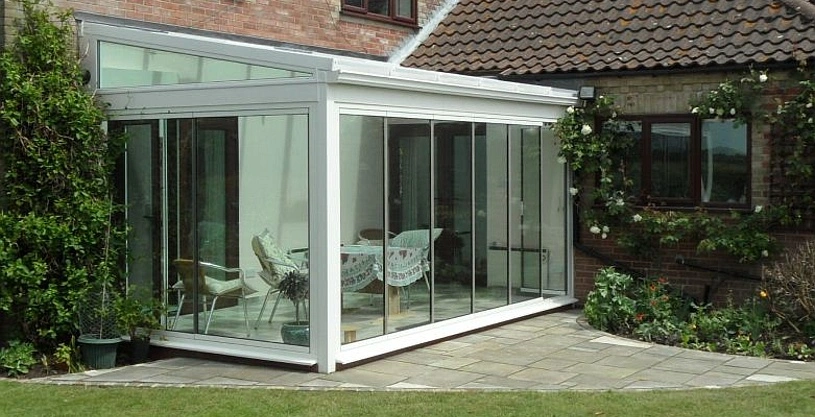
Special interlocking sections maintain security where the doors meet at the corner. The frames include additional sealing points to keep weather out at this vulnerable junction. Some systems use magnetic seals that pull the doors together as they close, ensuring proper alignment every time.
Floating corner designs need proper structural support above. Steel beams hidden in the roof carry the weight that would normally rest on a corner post. This engineering allows the doors to operate safely while providing the wide views many homeowners want.
Weather Protection Features
The latest conservatory sliding doors include multiple layers of protection against rain and wind. Deep drainage channels catch any water that gets past the outer seals, while carefully designed sills direct it away from your conservatory floor.
Thermal breaks in aluminium frames stop cold spots forming around the edges. This technology, combined with modern glass coatings, helps maintain steady temperatures inside your conservatory. Some systems use triple glazing in exposed locations, though double glazing usually suffices for most UK homes.
Flush threshold patio doors require extra attention to weatherproofing. Channel designs manage water while maintaining level access. Some manufacturers use replaceable wear strips where the doors slide, extending the life of the main frame components.
Security Features
Modern external conservatory doors incorporate multiple security features. Multi-point locks engage at several points around each sliding panel, making it extremely difficult to force them open. Toughened or laminated glass often comes standard, protecting against both accidental damage and deliberate attack.
Special anti-lift blocks stop criminals removing panels from outside. Concealed fixings mean there are no exposed screws to tamper with. Many systems now include prepared spaces for smart locks or alarm sensors, letting you integrate your doors with home security systems.
Internal beading holds the glass in place from inside the conservatory, making it impossible to remove panels from outside. High-security cylinders resist picking and drilling, while reinforced keeps strengthen the locking points. Some manufacturers add anti-snap cylinders as standard, protecting against common break-in techniques.
Design Choices for Conservatory Sliding Doors
Modern patio doors can make or break a conservatory’s success. Well-chosen conservatory sliding doors improve both practicality and visual appeal. Poor choices might leave you with temperature control issues or awkward spaces.
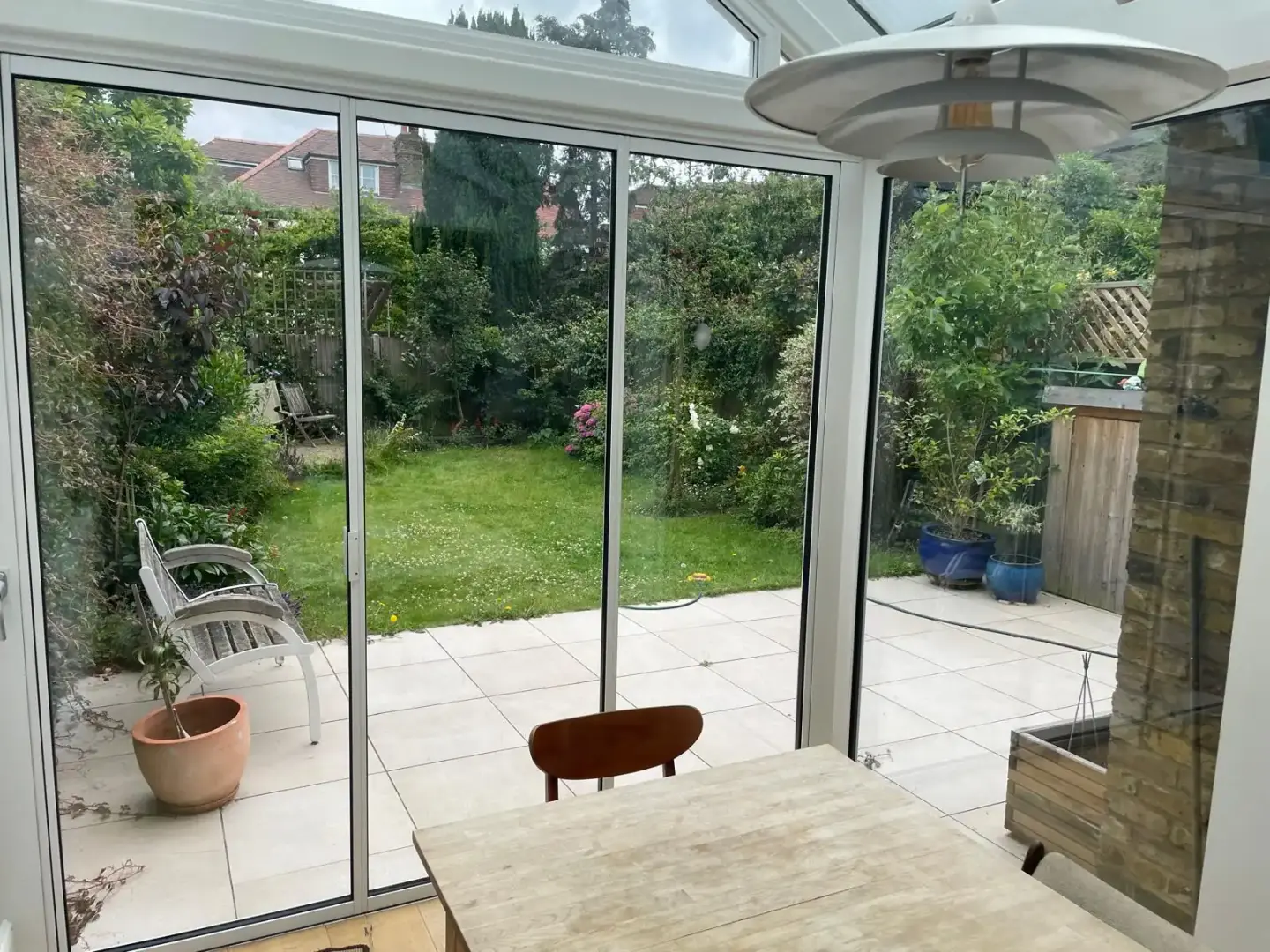
Making the Most of Available Space
A conservatory with patio doors needs careful planning to work well. The position of fixed and sliding panels affects furniture placement, air circulation, and how you use the room.
External glass doors work best when their tracks align with your conservatory’s structure. Frame size matters: thick frames provide strength but can block light, while minimal sliding doors use advanced materials to stay strong with less visible frame. A conservatory with sliding doors should have its panels set back from the roof edge to create shade in summer without losing winter sun.
Light and Temperature Management
Your conservatory sliding doors play a key part in managing light and heat. Slim sight lines help sunlight reach deeper into your room, but the glass specification needs to balance light with temperature control. Conservatory patio doors with solar control glass cut heat gain in summer.
Smart panel configurations let you adjust ventilation as needed. Modern conservatory sliding doors with sections on opposite sides help create cooling air flow in summer. Some conservatory doors include trickle vents in their frames, providing background ventilation even when closed.
Frame Colours and Finishes
Paint technology now offers lasting colour for aluminium frames. High-quality conservatory sliding doors come with dual colour options that let you choose different shades for inside and out. Modern conservatory doors might have grey outside matching your windows, with white inside to reflect light.
The main frame colours trending now include:
- Dark greys and blacks for modern homes
- Heritage greens and creams for period properties
- Metallic finishes that change in different lights
- Wood-effect coatings that don’t need maintenance
Bringing Everything Together
Glass choice affects both looks and performance in conservatory sliding doors. Low-iron glass provides clearer views than standard glass, while advanced coatings maintain comfortable temperatures. A conservatory with patio doors facing south often needs better solar control than north-facing ones.
Handle styles should match your home’s other fittings. Quality conservatory sliding doors include slim handles that sit close to the frame. The latest conservatory doors feature soft-close mechanisms that prevent slamming while pulling the doors fully shut.
Door layout affects both looks and practicality in sliding conservatory doors. Placing the main sliding section where it won’t clash with furniture makes daily use easier. Your conservatory patio doors might offer quarter-point sliding panels rather than just splitting in half, giving you more options for opening widths. Think about which parts of your garden you want to see – well-placed fixed panels frame these views while sliding sections open to useful areas.
Maintaining Comfort and Security with Sliding Conservatory Doors
Properly specified conservatory sliding doors control heat and protect your home. Material choice affects both performance and maintenance – aluminium patio doors resist warping but cost more than UPVC options. Well-fitted conservatory doors help maintain steady temperatures all year.
Thermal Performance
Modern glass technology makes a conservatory with patio doors highly energy efficient. Double glazed panels trap air between their panes, while special coatings reflect heat back into your room. Installing conservatory sliding doors with thermal breaks in their frames stops cold spots forming around the edges.
Heat loss through sliding conservatory doors varies between materials. UPVC patio doors provide good insulation at lower cost, though their frames tend to be thicker. The latest aluminium systems include polyamide strips between inner and outer sections that block heat transfer while keeping slim frames.
Security Features
Multi-point locking mechanisms secure conservatory sliding doors at several points along their frames. Toughened glass comes as standard, with laminated options available for extra protection. Your conservatory patio doors should include anti-lift devices that stop panels being removed from outside.
Modern conservatory doors incorporate hidden security features. Lock cylinders resist drilling and picking, while reinforced keeps strengthen closing points. Sliding internal doors between your home and conservatory need similar protection – intruders who get into conservatories often try to access the main house.
Noise Control Options
Exterior doors need careful design to reduce noise. Quality conservatory sliding doors use brush seals and rubber gaskets between panels to block sound paths. Extra wide air gaps between glass panes help cut noise while improving thermal performance.
Sound insulation starts with proper installation. Conservatory doors work best when fitted with precision – even small gaps can let noise through. The range of styles available includes options specifically designed for noise reduction, using laminated glass that dampens sound waves.
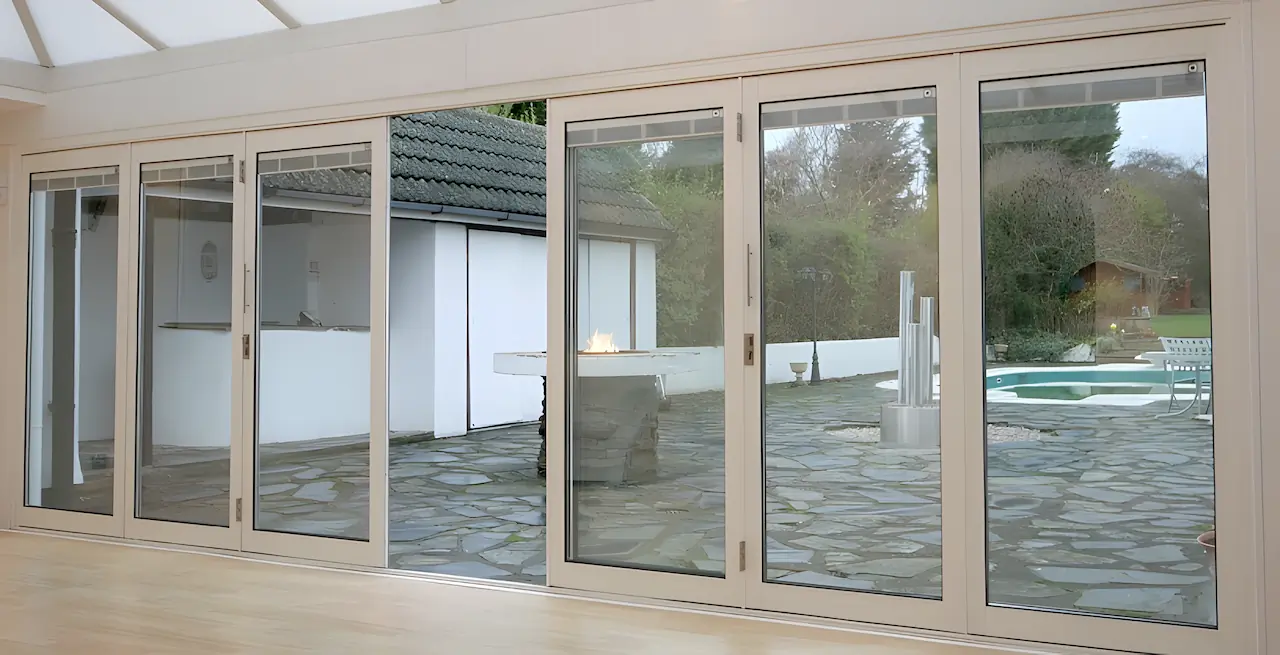
Ventilation Systems
Built-in ventilation helps prevent condensation in conservatory sliding doors. Modern systems include discrete vents that provide fresh air without compromising security. A conservatory with sliding doors benefits from controlled airflow, preventing moisture build-up in winter.
Location affects which ventilation options work best. North-facing conservatory doors might need less ventilation than south-facing ones that get direct sun. Trickle vents let you maintain background airflow even when your doors are locked.
Year-Round Maintenance
Regular cleaning keeps conservatory sliding doors running smoothly. Track maintenance matters – debris in the runners can affect how well panels slide and lock. New conservatory patio doors include accessible drainage channels that need occasional clearing to work properly.
Different colour choices affect how much maintenance your doors need. Light colours show dirt more quickly but hide scratches better than dark shades. Powder-coated conservatory doors only need washing with soapy water, while uPVC benefits from specialist cleaners that help prevent yellowing.
Moving parts need occasional attention to stay secure. Door rollers might need adjusting as they wear, while locks benefit from annual servicing. Professional maintenance of conservatory sliding doors prolongs their life and keeps insurance valid.
About SunSeeker Doors
With over 20 years of experience, SunSeeker Doors remains at the forefront of door design with our quality-tested patio doors and related products, including the bespoke UltraSlim aluminium slide and pivot door system, Frameless Glass Doors, and Slimline Sliding Glass Doors. All of our doors are suitable for both internal and external use.
To request a free quotation, please use our online form. You may also contact 01582 492730, or email info@sunseekerdoors.co.uk if you have any questions.


